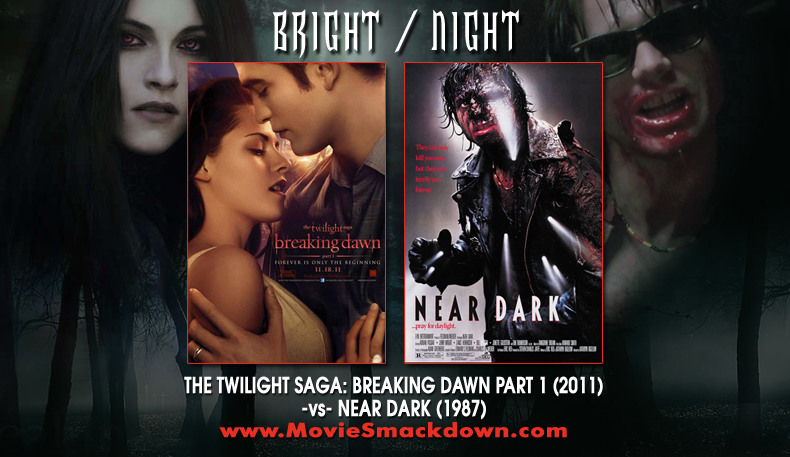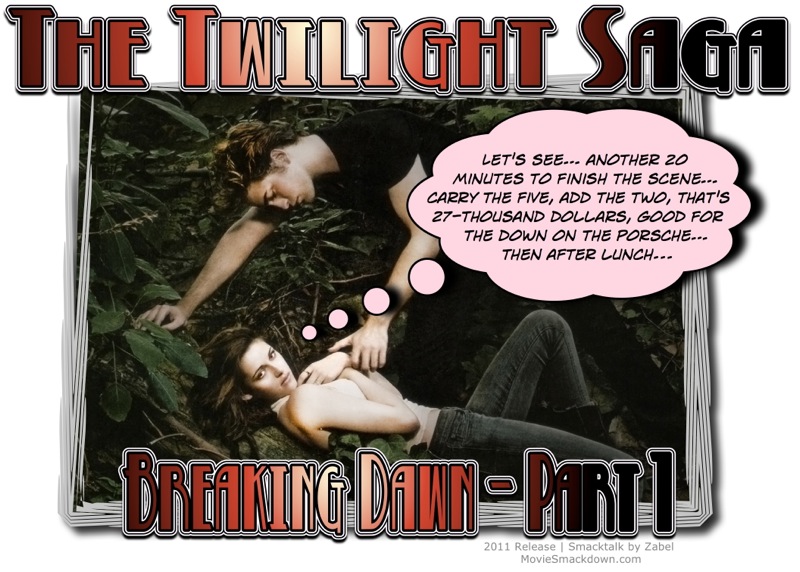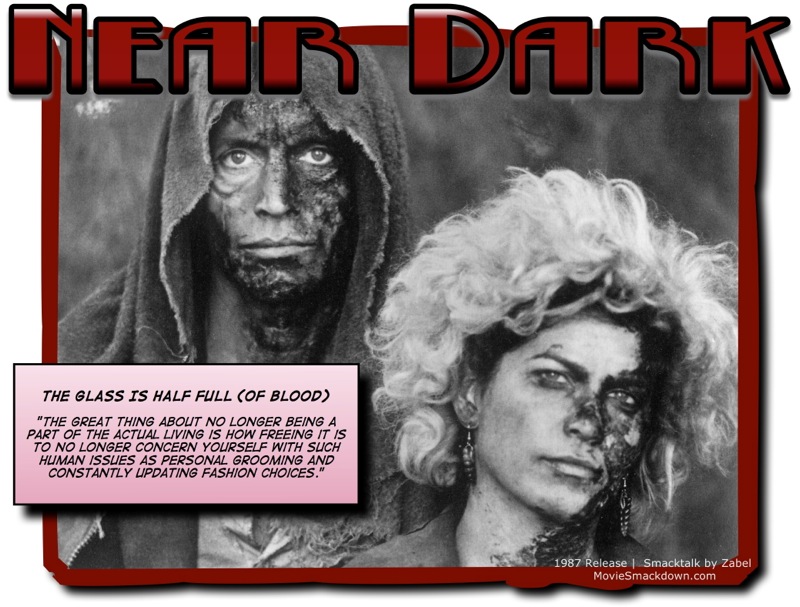
The Smackdown
Being a vampire used to be a heck of a lot easier. Dracula would suck his victims bone-dry, lure a beautiful woman to his castle, where he would turn her into a creature of the night to live with him forever, and that was that. No worries, no angst, no regrets. Nowadays, vampires have souls. They struggle to control their inner urges to feed on human flesh, while they cling to whatever’s left of their humanity. This is certainly the case for the vampires in The Twilight Saga: Breaking Dawn – Part 1 and Near Dark. One thing remains the same, though. Vampires have always been and continue to be smoking hot.
 The Challenger
The Challenger
Breaking Dawn, the fourth of the five-film franchise, finally takes the relationship between Bella Swan (Kristen Stewart) and Edward Cullen (Robert Pattinson) to the next level. No, they don’t exchange keys; it’s even better than that. Eighteen-year-old Bella and her knight-of-the-dark in shining skin, Edward, unite for the wedding of the century. And after the wedding comes the traditional wedding night – as traditional as a vampire and human can make it. Besides the accidental sex wounds, Bella appears happier than ever, until later, the motion sickness begins, and she reveals to Edward that she’s late, which leads them to a horrifying conclusion. Bella is pregnant. Though the baby’s life could cost Bella her own, delivering the fetus/baby/thing is a chance she’s willing to take, and with the help of Edward, her best friend Jacob (Taylor Lautner) and the rest of the Cullen clan, Bella’s not worried.
With Breaking Dawn’s box office numbers rolling in, it is apparent that Stephenie Meyer’s Bestselling Twilight novels and Summit Films have stumbled upon the surest solution yet to combating our national debt. And it obviously doesn’t matter who’s running the show. Bill Condon does a fine job directing the new film, the fourth different director to tackle a film in the series.
 The Defending Champion
The Defending Champion
Before she became the first woman to win an Academy Award for Best Director and James Cameron’s wife/ex-wife, Kathryn Bigelow wrote and directed the vampire flick Near Dark in 1987, with the help of co-writer Eric Red. In the film, the characters never refer to the term, “vampire.†But come on. You don’t have to be Van Helsing to recognize a cold, bloodthirsty creature that burns in daylight and won’t die from a few bullet wounds.
Caleb (Adrian Pasdar) thinks he’s innocently flirting with a sexy woman, Mae (Jenny Wright), but when he can’t take a hint that she needs to get home before the sun comes up, she turns Caleb into… what she is. Caleb’s father and sister witness Caleb’s capture and they spend the entire movie searching for him. Mae encourages Caleb to feed in order to survive, but Caleb at first refuses to give in to this new, abhorrent, physical need. Because of his choice, Mae’s coven consisting of Severen (Bill Paxton), Jesse (Lance Henriksen), Diamondback (Jenette Goldstein) and Homer (Joshua John Miller) give Mae one more chance to teach her boy-toy the ways of the dark world. If she fails, punishment for Caleb is death.
The Scorecard
Jam-packed with explosions, fires, blood and awkward Bill Paxton quotes, Near Dark displays a little more of what we’ve come to expect from a vampire film. None of the characters need even mention the word “vampire,†yet there’s no confusion about this story’s conventions. That’s a credit to Bigelow, who also helps her case by altering the rules a bit to save Caleb and Jenny’s lives.
Bella voices loud and clear in the first Twilight movie that Edward Cullen is in fact a vampire, so no confusion here either. These vampires actually have the capacity to mate and reproduce with humans—a bit of a departure from classic vampire lore. But if fans can accept vampires who sparkle in the daylight, any other modifications to the traditional construct shouldn’t be too hard to accept either. Besides, what really makes it work is that the characters are just as stunned as the audience. No one thought it was possible, except Stephenie Meyer, of course.
Something both movies share is a raft of unconvincing performances from fairly talented casts. Not that either film requires Olivier or even Vincent Price, but it would be nice to be able to connect with the characters. Bill Paxton’s Severen, who gets his kicks out of playing with his food before he eats it, triggers a few laughs, perhaps intended, with comments like, “It’s finger-licking good.†He is hands-down the most enjoyable part of Near Dark. The love between Caleb and Mae is forced and doesn’t hold up after Mae seduces him and turns him into a vampire. Similarly, Breaking Dawn relies too heavily on dialogue to prove the young couple’s burning love; you’d never guess it by watching the apparent lack of chemistry between Stewart and Pattinson on screen. Taylor Lautner, on the other hand, gives a heartfelt performance when he realizes Bella is dying. And even when Lautner’s not so angry, his tight abs and baby-face are supplemented by a sympathetic performance—one of the few in either film.
Despite the acting shortcomings, Bill Condon successfully brings true love back to the Twilight franchise without it feeling awkward, as it did in the first film, or humorous, as in the third. (The second film didn’t even try.) The romance is there, all right—steamy, pure and tragic. Condon, who has directed five Oscar-nominated performances in the past but doesn’t look to be adding to that number here, will be staying on to direct Part Two. This gives a few brownie points to Breaking Dawn. While Bigelow’s intense action sequences show signs of her future greatness, the characters in Near Dark seem one-dimensional and often confused. Caleb doesn’t know whether to stay with the coven or return to his family, and his kidnappers don’t know whether to keep him or kill him. If these sound like boring plot points, that’s because they are. This film scored big with critics for its unconventional portrayal of vampires as modern characters, laying the groundwork for writers like Meyers. But 24 years later, I can’t say the example holds up particularly well.
The Decision
Everybody has a guilty pleasure, and that’s really what this Smackdown comes down to. Both films are made for specific audiences. If you enjoy films with explosions, fires and blood-spatter punctuated by a small, mediocre story to fill in the gaps, Near Dark is the movie for you. Although I do like a good explosion from time to time, I can’t help but fall for romance. This is by far the best Twilight movie I’ve seen, because this time, the danger of Bella dying overcomes the lackluster performances and is more traumatic and emotional for the rest of the cast than ever before. Breaking Dawn: Part One takes this Smackdown trophy





I can’t even begin to put into words how superior Near Dark is. I’m not going to pull dissect the inferiority of Twilight but surely for anyone with any taste it’s glaringly obvious. Isn’t it?
The Twilight Saga- Breaking Dawn Part 1, beats any vampire film hands down thank you, there is no need to do a survey on it- WHO CARES ABOUT ANY OTHER VAMPIRE FILM?